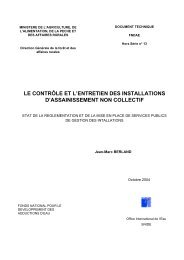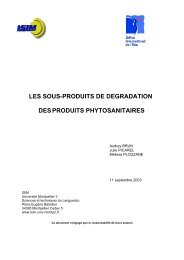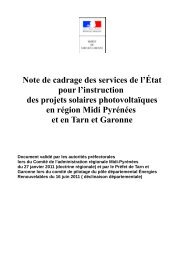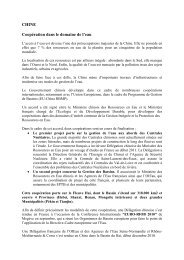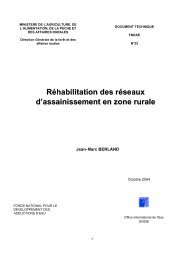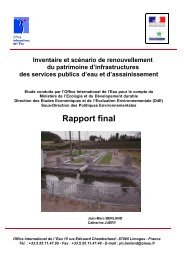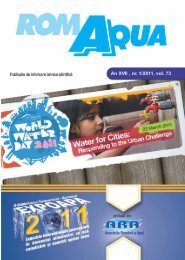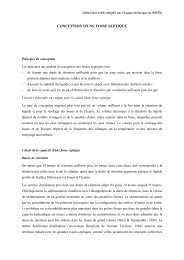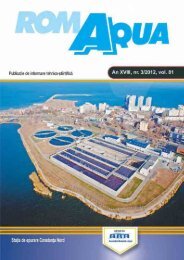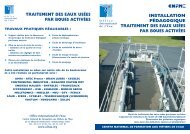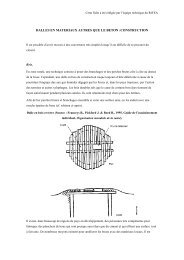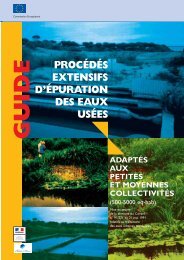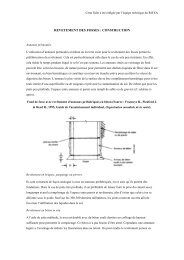vol 77 n° 5 2011 - Office International de l'Eau
vol 77 n° 5 2011 - Office International de l'Eau
vol 77 n° 5 2011 - Office International de l'Eau
You also want an ePaper? Increase the reach of your titles
YUMPU automatically turns print PDFs into web optimized ePapers that Google loves.
STUDII SI CERCETARI<br />
Pilot project for <strong>de</strong>velopment of an intake management system<br />
of the Prut and moldova river in iaşi<br />
efectul staţiilor <strong>de</strong> tratare a apei şi influenţele posibile ale<br />
reţelelor <strong>de</strong> distribuţie) trebuie să fie bine înţeles.<br />
Acest lucru <strong>de</strong>vine din ce în ce mai important în<br />
contextul în care infrastructura din întreaga lume e<br />
din ce in ce mai îmbătrânită, şi cu atât mai mult în<br />
cazul în care este luată în consi<strong>de</strong>rare construirea<br />
<strong>de</strong> noi şi costisitoare instalaţii <strong>de</strong> potabilizare. O<br />
apă potabilă poate fi produsă doar dacă apele brute<br />
<strong>de</strong> la sursă (<strong>de</strong> suprafaţă) sunt nepoluate. Calitatea<br />
apei din reţea <strong>de</strong>pin<strong>de</strong> în mod cert <strong>de</strong> performanţele<br />
tehnologiilor <strong>de</strong> tratare a apei şi, în mod similar,<br />
performanţele proceselor <strong>de</strong> tratare sunt <strong>de</strong>pen<strong>de</strong>nte<br />
<strong>de</strong> calitatea apei la sursă. Evaluarea calităţii apei la<br />
sursă este esenţială pentru exploatarea instalaţiilor<br />
<strong>de</strong> tratare a apei, în două scopuri: pentru a evalua<br />
dacă un sistem <strong>de</strong> tratare existent este capabil să furnizeze<br />
apă potabilă <strong>de</strong> buna calitate, şi pentru a concepe acele<br />
tehnologii <strong>de</strong> tratare care să poată face faţă la variaţiile<br />
parametrilor şi la evenimente generatoare <strong>de</strong> valori <strong>de</strong><br />
vârf, în ceea ce priveşte contaminarea apei la sursă.<br />
În România, monitorizarea calităţii apei se bazează<br />
foarte mult pe prelevări <strong>de</strong> probe la faţa locului, urmate<br />
<strong>de</strong> măsurători analitice instrumentale în ve<strong>de</strong>rea<br />
<strong>de</strong>terminării concentraţiilor <strong>de</strong> poluanţi. In ciuda<br />
unor avantaje, această procedură are o limitare consi<strong>de</strong>rabilă<br />
în ceea ce priveşte: a) rezoluţiile temporale<br />
şi spaţiale care pot fi realizate la un cost rezonabil, şi b)<br />
obţinerea <strong>de</strong> informaţii privind bio-disponibilitatea. Problema<br />
majoră, în ceea ce priveşte protecţia sănătăţii<br />
publice, este faptul că (in cea mai mare parte), monitorizarea<br />
calităţii apei potabile este reactivă, în<br />
sensul că orice eveniment sau avarie în sistem poate<br />
dura mai multe ore, înainte <strong>de</strong> a fi <strong>de</strong>tectat prin monitorizare<br />
şi măsurare a parametrilor <strong>de</strong> rutină.<br />
Acest lucru este legat <strong>de</strong> strategia <strong>de</strong> monitorizare,<br />
care este, în mod tradiţional, axată pe apa care se<br />
introduce şi/sau care iese din staţiile <strong>de</strong> tratare şi<br />
sistemele <strong>de</strong> distribuţie. În timp ce parametrii<br />
măsuraţi in mod tradiţional s-au dovedit a fi utili şi<br />
încă mai au un rol important, adoptarea şi utilizarea<br />
<strong>de</strong> instrumente mo<strong>de</strong>rne si ieftine <strong>de</strong> monitorizare<br />
se poate adăuga programelor <strong>de</strong> monitorizare care<br />
nr.5 / <strong>2011</strong> www.romaqua.ro<br />
being consi<strong>de</strong>red.<br />
Safe water can only be produced if source (surface)<br />
waters are pollutant-free. The water quality in<br />
the network is for sure heavily <strong>de</strong>pen<strong>de</strong>nt on the<br />
performance of the water treatment steps. Similarly,<br />
the performances of treatment processes are <strong>de</strong>pen<strong>de</strong>nt<br />
on water quality at the source. Assessment<br />
of the quality of source water is essential in operating<br />
drinking water treatment plants: to evaluate if an<br />
existing treatment system is able to provi<strong>de</strong> safe drinking<br />
water and to target the treatment to cope with variations<br />
and peak events in the contamination of source water.<br />
In Romania, water quality monitoring relies<br />
heavily on spot sampling followed by instrumental<br />
analytical measurements to <strong>de</strong>termine pollutant<br />
concentrations. Despite a number of advantages,<br />
this procedure has consi<strong>de</strong>rable limitation in term<br />
of: a) temporal and spatial resolution that may be<br />
achieved at reasonable cost, and b) the information on<br />
bioavailability that may be obtained. The major problem,<br />
in terms of public health protection, is that (for<br />
the most part) monitoring the safety of drinking<br />
water is reactive, in the sense that any event or<br />
breakdown in the system can occur many hours, before<br />
it is <strong>de</strong>tected by monitoring for any of the routinely<br />
measured parameters. This is related to the<br />
monitoring strategy, which is traditionally focused<br />
on water as it enter and/or leaves the treatment<br />
plants and on the distribution system. While traditionally<br />
measured parameters have proved useful<br />
and still have an important role to play, the establishment<br />
and use of emerging and low cost tools as<br />
part of monitoring programs may complement<br />
monitoring already in place by providing additional<br />
information with the aim to obtain a more representative<br />
picture of the quality of a water body.<br />
Un<strong>de</strong>r the partners for Water program, ApAVitAL<br />
iasi and Dunea the netherlands are financed<br />
by Dutch Ministry of Economic Affairs through its<br />
executing agency AgentschapnL to <strong>de</strong>velop in partnership<br />
an early warning system for the intake of<br />
surface water from the Prut and Moldova Rivers. In<br />
7



